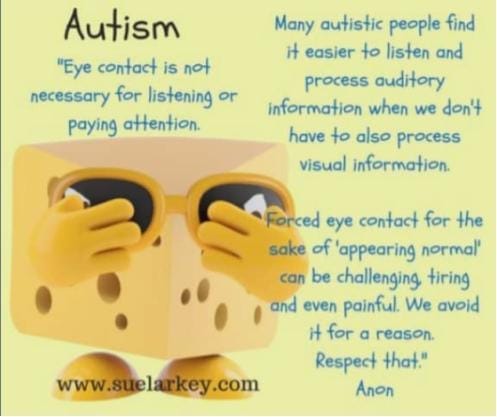Subscribe to my podcast via my podcast page to get weekly episodes about ASD just like this one delivered automatically to where ever you listen to podcasts.
Eye Contact
I’ve had a lot of questions in regards to eye contact and understandably so since eye contact is an important part of communication and socialisation. It demonstrates an awareness of and interest in the other people. However, for children with ASD it doesn’t come naturally and has even been reported as ‘painful’ by people with ASD to look at people’s eyes. In many cases when children are not looking at people’s eyes /faces, people assume the child is not paying attention or listening. However, we must be cautious not to assume that not looking means not listening, in fact many children report listening best with their eyes closed or when they look away.
Teaching eye contact is very difficult, as in society when we communicate we actually use an ‘eye gaze’ rather than eye contact (staring into eyes). I’ve had students who have been taught eye contact rather than eye gaze, they then tend to stare deep into your eyes, which people generally find very uncomfortable too. I prefer to teach Eye gaze through looking at people’s faces rather than directly at the eyes. Some children are best if you choose a specific part of the face, like ears, eyebrows, mouth or nose. It is an important skill to teach students to look in the direction of the speaker and at their face if possible.
Recommended Strategies to Encourage Eye Contact
- Model appropriate eye contact with your child; always turn to look at your child when you talk to them.
- Bring object/toy up to your eye level to encourage your child to look. Initially they may only look at the toy but gradually some eye contact will emerge.
- Sometimes gently touching your child’s chin can be a reminder to look BUT DO NOT DRAG YOUR CHILD’S FACE ROUND to make them look.
- Stand in front of your child when they are on the swing/rocking horse etc. Occasionally stop the swing and say “Ready, set” – wait a few moments in the hope that they may look at you and then immediately say “Go”. As they turn to look at you more readily you can encourage a vocalisation for ‘Go’.
- Blowing bubbles, and then waiting, is often a successful way of eliciting eye contact.
- Use a variety of ways to gain your child’s eye contact. Do not constantly nag him with “Look at me, look at me”.
- Some children feel more comfortable when engaged in agross motor activity, e.g. on the swing, having a tickle. The child may give spontaneous eye contact during these activities.
Tracking Skills
A great starting point before teaching eye contact/gaze is tracking. Some children need to be taught to ‘track’ or follow an object with just their eyes, as they tend to move their whole body to look. Tracking is important skill as it is used in everything from following a visual schedule to reading.
Recommended Strategies to Teach Tracking/Scanning
Use a range of activities to encourage children to use their eyes to track scan e.g.
- Blowing bubbles, throwing feathers in the air, balloons.
- Sparklers: move around and get child to follow.
- Torch activities: follow the light along the wall. Cover torch with different colours to make interesting.
- Toys that move on their own, remote, pull back and let go so eyes follow object.
- Roll a ball, extend range and length of rolling.
- Throw at target activities.
- Looks: If the child likes books looking at the pictures can be great. Pop up books can be used if not as interested in books as these are often more interesting.
- Puzzles: Start with their special interest and quick puzzleswhere they just need to look quickly to complete puzzle then build up.
- DVDs/TV shows can teach looking and scanning.
Excerpt from Practical Communication Programmes by Jo Adkins and Sue Larkey (Pg 45 and 46).

Most Popular Resources for Teaching in the Early Years
By Sue Larkey and Gay von Ess
The Early Years has been designed as a ‘how to’ book that parents, teachers and carers can refer to for help in managing behaviour, promoting communication, establishing basic attending skills and for introducing new activities to young children with autism spectrum disorder or developmental delays. Full of practical ideas to give children with ASD and other developmental delays the KEYS to learning. Teaching to play, write, draw, imitate etc. Toileting training, community access, etc. To sit, ask for help, wait, play, attention to task, sign songs, etc. Great easy to photocopy programmes.



 Sorry we no longer ship items outside Australia. Please consider the digital versions of Sue’s Books –
Sorry we no longer ship items outside Australia. Please consider the digital versions of Sue’s Books – 